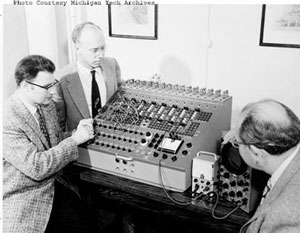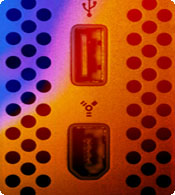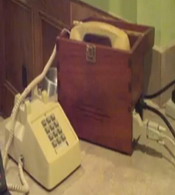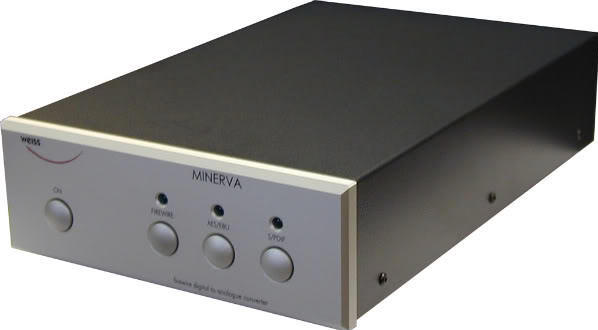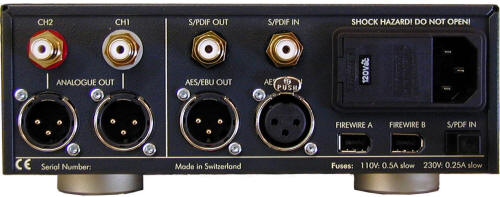|
You are reading the older HTML site Positive Feedback ISSUE 44july/august 2009
The
cure for the sound of Analog and the convenience of
Digital
- the Amarra Playback
Software and the Weiss Minerva Firewire DAC
There have been some interesting breakthroughs in the world of digital audio… mostly for convenience reasons through, I should add. CES '09 was a real eye opener. I'd say about 30% of the rooms had some sort of PC based audio playback device that would convert USB to SP/DIF. Most of the ones I had seen made me chuckle a bit inside, as they just didn't seem to get it. The majority of them seemed to have just "jumped on the bandwagon." Hey, look… I've got a magic box that will convert USB to SP/DIF… $399. What?? Most of these little boxes were just the run-of-the-mill delta sigma chipset that would do a maximum 48 KHz sample rate at 16 bits. For the casual CD listener this might suffice. There are a lot of other things at play here that are like the icing on the cake.
I suppose by now just about everyone has heard of Sonic Studio's newest inception: Amarra. At first, I just didn't buy it. I had heard a few flawed demos involving several other pieces in the chain manipulating the audio signal and it just sounded too stale to me. Essentially, what Amarra does is play back audio files using iTunes as its GUI. It skips the playback portion of iTunes and uses its own mathematical equations to compute the audio data. Sonic Studios claim bit perfect output! Is it? Well, while I will admit I do not have the correct measuring equipment to prove this, I will say that it does sound quite different. More on this later…
I stumbled upon a room that was using not only Amarra, but the Weiss Minerva DAC. "What a simple looking device," I thought. 3 buttons, 3 LED's and that's it. No fancy display, no esoteric buttons and knobs to twiddle. Where the real magic is, is inside. This DAC was made from the ground up to operate on the Firewire bus of a computer. There are a lot of audiophiles out there that don't understand the differences between USB and Firewire, so I will divulge just a little bit (back to the Weiss in a moment.)
USB was originally created years ago to try and get rid of the serial port on the PC. This serial port was extremely limited in bandwidth, and was used mainly for a mouse or a modem. USB, or universal serial bus, replaced it claiming not only faster speeds, but plug and play. Plug and play wasn't really streamlined until Windows XP came out, in my opinion, but by now I'm sure everyone has a memory thumb stick or a USB mouse/keyboard. These days it's quite simple: you plug it in, and, 90% of the time, the PC recognizes it—wham, there it is on your screen. For the PC-based audio world, there are quite a few limitations that have only been overcome by some of the best programmers out there. Mainly, out of the box USB is very generic. 90% of the USB DAC's on the market today use the same off-the-shelf chip, not only limited in bit rate, but also in the way it shares data bandwidth with the rest of the computer's devices. One interesting fact: Firewire was created first as an audio/video transport. USB was created first as a data transport. I don't want this article to get too technical here, as there are hundreds of articles on the web about the differences of Firewire and USB. USB is really catching up; I will not dismiss several companies out there that embrace the interface by creating their own subset of drivers and code to get the best out of it. In my opinion, Firewire still has it beat. USB's overhead is reliant on the CPU of the computer, which as you might know is doing lots of things at once. It wouldn't be a computer if otherwise! The beauty of Firewire is that it is its own manager. All of the overhead is on the device itself and that is it. The bad thing is that most devices that embrace Firewire aren't cheap. They have to be designed from the ground up, which takes lots of time and money. The end result, though, is something interesting…
Back to the Weiss unit—when at CES I stepped into a room and heard some real magic. It was all run by a Mac book using iTunes and Amarra through the Firewire interface to the Weiss. How to describe it? No ice pick stuck in one's ear! Very rich, detailed, with a notably open soundstage. I started to do some reading on this unit, and the specs were very impressive. You can even use it as your system's preamp if you are after the minimal approach (has a volume control feature.) Where this unit really shines is its extremely high sample rate capabilities. If you haven't paid a visit to www.hdtracks.com, you might want to spend a few minutes to get an overview of what to expect. This site offers re-mastered audio in high resolution for playback on these types of DAC's, and let me tell you it's really starting to get good. Gone are those nasty digital artifacts and what some of my Analog loving friends refer to as "digititis." The timing and the beat is back my friends. The air, the soundstage, the presence; these are the things the Vinyl junkies will talk about for hours on end! Trust me—I get it. I have heard some of the nicest Analog rigs out there and let me tell you, there is just nothing like it. I think we're getting close though. What I've been recently having fun with are high resolution digital recordings of Vinyl/Tape records. Most of these are recorded from people that own all of the gear and software to lay down a nice digital version of the analog giant. It's not too expensive, considering that the turntable and the phono stage is where most of the money is invested. All you need aside from that is an ADC, or analog to digital convertor. There are 100's of these on the market today, Firewire and USB. On top of that you will need some decent recording software (another forté of Sonic Studios) to record and cut up the songs with. I intend on getting more into this with another article in the future.
The Weiss unit sports not only two Firewire interfaces (as one can daisy-chain these devices) but also fully balanced outputs if one desires. Not only that, but it can be interfaced with several other Weiss units that perform other digital type duties. It's quite compact in size and blends in quite well with other equipment (doesn't steal the show.) It would be nice if they offered a black faced bezel if one preferred, but for now it's silver.
So, what about the sound? Well, the real intent of this article is to describe the synergy of both Amarra and Weiss. It wasn't until these two were put together that I was really impressed. There seems to be a certain magic with using this duo together, considering Amarra was originally written to work with this unit as well with their own proprietary suite of DAC's and other pro-audio-related gear. A huge feature that I found beneficial –is the ability for auto sample rate switching. I'll describe my life pre-Amarra: Let's say you are listening to a standard audio CD consisting of 16-bit/44.1 KHz, which 90% of your library probably is. You then decide that you want to throw on that higher resolution version of the album with the flick of a remote control. Well, iTunes will output the music, but not in its native sample rate. One must first shut down iTunes, go into the audio setup applet on the Mac, and change its sample rate output to match that of the music. Then, you launch iTunes and play back the music. Wait a second, isn't this all about convenience here? Amarra will automatically adjust these settings on the fly depending on the music being played. As it stands, there are limitations with Amarra's file formats. It will currently only play back uncompressed audio—yes, even lossless compression doesn't qualify. This is a huge drawback, in my opinion. But, according to Sonic Studio's Jon Reichbach, this will change soon. I personally have 90% of my audio stored in Apple Lossless, since it does save me about 30% of disc space this way. There are some stipulations that fully uncompressed audio sounds better than apple lossless due to the CPU overhead of real-time uncompressing, but this is something I've not witnessed just yet (and refuse to get into on this article.) Yes, hard drives are getting cheap, so who cares, right? Well, I personally have data redundancy (RAID 5) so it's not as cheap as it seems. When you've got as much data I do, you really don't want to rely on one single hard drive and no backup. Ripping CDs and movies takes a lot of time and patience, and considering the fact that most hard drives these days average about two years life expectancy, you're just asking for trouble if you don't protect your investment of time and effort. Anyway, as mentioned earlier, Amarra is simply a plug-in for iTunes. Its options are limited, which in my opinion is a good thing. Playback is happening in real-time with iTunes, so basically the file you're listening to is playing back from both iTunes and Amarra at the same time. When Amarra is enabled, it simply mutes iTunes. This comes in handy when doing A-B comparisons. When Amarra is disabled, it stops processing the file and un-mutes iTunes. There are minute delays but nothing too difficult to deal with. A few other features of Amarra: a built-in equalizer and dither control. I haven't had much time to play with the equalizer, but it seems quite powerful, offering high shelf, parametric and low shelf adjustments. On another menu, there are dithering options allowing one to turn on dither if you are applying any gain in the digital spectrum (something you should do according to Jon Reichbach). I've also tried using it either to bring 16-bit medium to 24-bit; I preferred this setting for my 16/44.1 material.
A spectrograph capture of the analog waveform recorded from vinyl. As you can see, it goes way beyond the standard 22 KHz Nyquist filter from a Redbook mastered CD. Here's the life of the recording! So far I've been having quite a bit of fun with the duo. I've had some friends over that scoff at ‘all that is digital' and have really blown their minds when exposed to what the combo can do musically. No one has left a demo I've given without having their thoughts on digital changed. I've played back vinyl both on my turntable and through Amarra (once recorded in 24-bit 96 kHz), and the results were staggering. Back is the soundstage, the presence, the airy magic. It's quite amazing and what's even cooler is that I can now control the music via my iPhone (or iPod touch) with the flick of a finger. I think a solution is finally here for the Analog junkies. You will have to invest in a bit more equipment here, but think about the possibilities, the convenience of PC-based audio playback, without having to wear out your wax. No more fussing with the cleaning rituals (although most analog junkies attest to this being quite a spiritual experience and enjoyable!) In the end, this has been quite a journey, and also the pinnacle of my PC-audio-based life as I know it. Amarra now works with most off the shelf DAC's, even allowing sample rate changes (albeit limited based on the actual DAC itself as far as sample rates go), and also offers a 30 day evaluation period to really get to know how it sounds. The price is a little high, but you have to remember Sonic Studio is no newbie in the business. They've been developing studio grade software for years and have really mastered the industry (no pun intended.) You can't go wrong here, playback software that offers the convenience of iTunes and the audio quality of how it was originally recorded. The Weiss DAC is probably the best I've ever heard, encompassing custom hardware and software geared for the highest fidelity audio playback possible, along with its own clock source to eliminate jitter over Firewire's Asynchronous communication method. I think that the real synergy here is both with the DAC and the software playing back the music though. As far as I'm concerned, this combination just can't be beat for sound quality. I will also add that I have heard Amarra on systems with their own DAC, and could not hear the differences when Amarra was toggled on and off as much as I could in my system. Can you hear the difference? You be the judge; from me—two thumbs up for changing not only my own views, but the stubborn views of some of the most stubborn Analog junkies on the planet!
Minerva Weiss www.weiss-highend.ch Amarra www.sonicstudio.com
|

